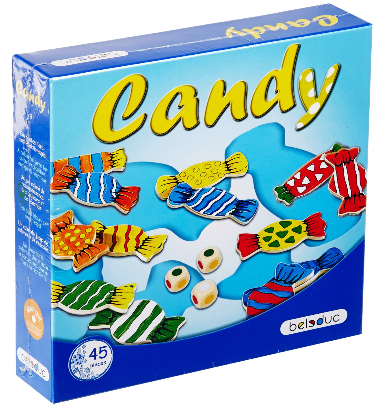 |
| Candy - Players hold three colors in memory while searching. |
Tobi and his sister Lisa received a bag of candy from their mother for helping her in the garden. They both tug on the bag at the same time and it breaks open. The candy spills out. The Candy game pieces are those pieces of candy and you will help them by picking up and dividing the candy.
Each individual game piece is a piece of candy. The pieces are wooden with a paper picture of candy. Each piece of candy has three colors - the outside twisted parts, the inside body of the candy piece and the design on the body of the candy (stripes, dots, triangles, etc.) The colors are red, green, blue, orange, white and yellow. There are three identical color dice. Each die has the same six colors, one color per side. The dice are wooden and smaller than your average white dice used in games.
Both I and the kids have liked this game and I have used it quite a bit.
Object:
Pick up the most candy.
Set up:
Place the blue cloth circle (tray) on the playing surface and scatter the candy pieces on top.
Play:
Taking
turns, each player will throw the three color dice to determine a
3-color combination. This 3-color combination must be held in the memory
as players scan the candy to find the exact piece. There is one piece
of candy for each color combination. For instance if you throw a red,
green and blue, you will look for a piece with those three colors. The
colors can be in any order on the piece of candy. If the dice come up
red, red, red, you will be looking for an all red piece.
From this point there are three versions for playing the game:
- Version 1 - Collect candy pieces. After each throw of the dice, all players will search for the candy piece with that 3-color combination. The first person to find that piece of candy picks it up. The game ends when someone collects five pieces of candy.
- Version 2 - Keep score. Play as above except point to the correct candy piece but leave the candy where it is. The player who finds the piece first gains one point. Play for an amount of time that is specified before the game starts, such as 10 minutes. Person with the most points after 10 minutes wins.
- Version 3 - Put back candy pieces. Randomly give each player five pieces of candy. Players throw the dice, in turn, and if you have the piece of candy with that color combination you get to return it to the blue circle. Whoever runs out of candy first, wins. This version will take longer as you will throw the dice many times to return only 10 pieces, most of the time no one will have a matching piece.
Try this:
- Tell the player to choose one of the three colors and only stop and check pieces with that color to eliminate stopping at every single piece to check for the 3-color combination. If it has that color, then check for the next color, etc.
- Place one piece of candy in front of the individual. Ask him to turn one die in the fingertips and find one of the colors. Place the die, color side up, on the table top. Repeat for the remaining two dice until you have all three colors showing on the dice.
- Throw only one die to start. Remove all the candy with that color.
- Throw only two dice. Remove all the candy with those two colors.
- Cup the hand to shake the dice. If the individual has difficulty with this, place a small ball into the hand and ask the individual to cup the fingers around it. Remove the ball and add the dice.
- Keep the hand in the cupped position longer by asking the child to count to 10 before throwing so you can watch the dice "dance".
- Listen for the dice "dancing" if the child tends to squeeze the dice in the hand and just move the wrist up and down.
- Shape both palms before shaking the dice. Drop the dice into the player's hand, and ask him to place the other hand over the top and shake.
- Instruct the child to repeat the color combination verbally to help him remember what he is looking for as he scans.
- Use game version 3 as you put the game away.
- Work on figure ground, visual discrimination, visual scanning, manual dexterity, palmar arch strength and development, in-hand manipulation, working memory, processing speed, socialization skills, process skills, executive functioning skills, play and leisure exploration and participation
In the box: 41 wooden sweet treats, 3 wooden color dice, 1 round cloth playing field
Ages 4+, 1-8 players
If you are interested in purchasing this game or just want more information, click on the image below.






No comments:
Post a Comment
Thank you for taking the time to comment.